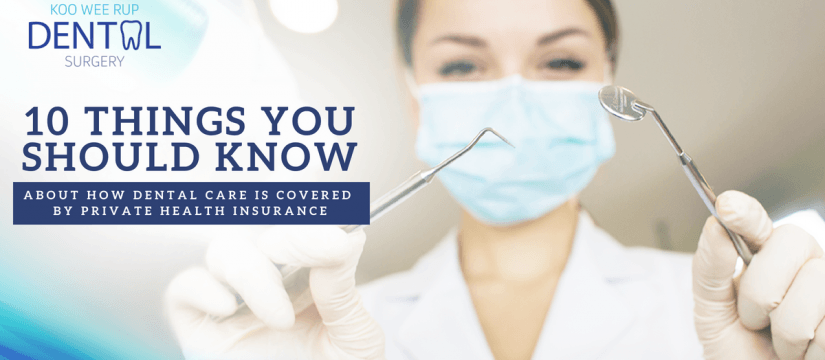
Deciding whether to get (or keep) private health insurance is getting harder and harder. With premiums going up substantially each year and rebates failing to do the same, more and more Australians are asking themselves the question: “Is private health insurance really worth it?”.
While it’s only natural that many of us would like to be covered for healthcare options and medical expenses not covered by Medicare, we’re also influenced by government policy – either penalising people who don’t have private health insurance, or rewarding those who do with a rebate, depending on who you ask – and the way the big health funds market their products.
And that’s before you factor in the confusion of sorting through some 20,000 different policies (according to the ACCC)!
What do dentists think?
Late last year, the Senate Community Affairs References Committee tabled the report of its Inquiry into the private health insurance industry.
The Australian Dental Association (ADA), organisations representing specialist dentists, and more than 160 dentists made submissions to the Inquiry, expressing concerns about the impact of private health fund practices on dental patients, and dental health care provision.
The Inquiry recommended legislative and policy change to rein in the unfair and anticompetitive practices of private health insurers in the dental services market and dental insurance space.
“We applaud the Committee for addressing many of the ADA’s concerns and making recommendations to ensure greater transparency, genuine choice of provider and equitable rebates for dental consumers, and a fairer, more level competitive playing field for dental health care providers”, ADA Federal President Dr Hugo Sachs said.
You can read the full ADA media release here.
How do you decide?
No-one can tell you whether you need private health insurance, let alone what level of cover, let alone which policy would be right for you and your circumstances. You’d need a crystal ball for that.
What we can do – and what we’re going to try to do now – is give you a list of some of the things you should consider when choosing the right dentist … from a dentist’s point of view.
1. Check your rebates
 For anyone who has private health insurance, there’s a good chance you’ve kept the same provider for years. The big funds rely on that consumer inertia, meaning they expect that once they’ve got you as a policyholder, they’ve got you for a long time. So, make a point of checking what you’re actually getting back over the course of a year, against what you’re paying. That’s the first step to answering the question we started with: “Is it really worth it?”.
For anyone who has private health insurance, there’s a good chance you’ve kept the same provider for years. The big funds rely on that consumer inertia, meaning they expect that once they’ve got you as a policyholder, they’ve got you for a long time. So, make a point of checking what you’re actually getting back over the course of a year, against what you’re paying. That’s the first step to answering the question we started with: “Is it really worth it?”.
2.Understand extras
 Most funds offer basic cover and then ‘upsell’ with what are called Extras. This optional, additional general treatment cover provides insurance against some of the costs of treatment by ancillary health service providers, including optometrists, physiotherapists, and dentists. To confuse you a little more, private hospital cover is often bundled in with Extras.
Most funds offer basic cover and then ‘upsell’ with what are called Extras. This optional, additional general treatment cover provides insurance against some of the costs of treatment by ancillary health service providers, including optometrists, physiotherapists, and dentists. To confuse you a little more, private hospital cover is often bundled in with Extras.
3. Look at the procedures covered
 Most dental procedures are covered, with the exception of some cosmetic procedures (for example teeth whitening), however the level of cover varies by policy and insurer.
Most dental procedures are covered, with the exception of some cosmetic procedures (for example teeth whitening), however the level of cover varies by policy and insurer.
Most private health funds split dental procedures into two categories, General Dental and Major Dental, and often what they categorise as General Dental treatments are covered by the default level health insurance plan.
General Dental mostly covers diagnostic and preventative treatments, and usually includes things like:
- Consultations
- Regular check-ups
- Comprehensive oral exams
- Scale and cleans
- Flouride treatments
- Minor fillings
Major Dental, which is usually part of any extras cover, takes in oral surgery and restorative procedures, including:
- Complex fillings
- Root canal fillings
- Extractions
- Crowns
- Orthodontics
4. Know your needs
 Firstly, check with your dentist to see what your dental condition is like and ask the dentist what your dental treatment needs are, and stage them in a timeframe – immediate, medium term, long term. Get the ADA item codes for these required treatments.
Firstly, check with your dentist to see what your dental condition is like and ask the dentist what your dental treatment needs are, and stage them in a timeframe – immediate, medium term, long term. Get the ADA item codes for these required treatments.
Secondly, based on the dentist advice, look at the existing policy to see if they cover these treatments, and be prepared to do the homework and compare different products out there in the market.
5. Shop around
 Don’t only look at the big-name health funds, as some of the smaller, less well-known companies offer policies that are much better value for money. This simple online comparison tool on the ADA website is the ideal starting point, particularly if your dental coverage really matters to you.
Don’t only look at the big-name health funds, as some of the smaller, less well-known companies offer policies that are much better value for money. This simple online comparison tool on the ADA website is the ideal starting point, particularly if your dental coverage really matters to you.
6. Watch out for the fine print
 Don’t get caught out by not reading the fine print before you take out or change your policy.
Don’t get caught out by not reading the fine print before you take out or change your policy.
Firstly, understanding that there is almost always a waiting period, although some funds waive that if you’re coming across from another provider on a similar policy. It’s usually two months for general dental but can be up to 12 months (the maximum allowed by the Ombudsman) for major dental.
Then there are the annual limits which generally apply to each category under extras coverage. A typical annual limit would be $1500, and the year they use is the calendar one (January 1-December 31), not the financial one.
There might also be other exemptions and restrictions. It’s too late to find that out when a claim is rejected.
7. Factor in your stage of life

It’s likely that young individuals and couples will find general coverage is enough to meet most of their needs, while families and older people will be more likely to be better served by opting for an extras policy that provides major dental coverage.
As a relatively young person, if you take advantage of the discounted preventative benefits to keep on top of your oral health, with any luck you won’t be looking at any major treatments.
As for those of us who are no longer all that young, it’s an unfortunate fact of life that our teeth, like a lot of other parts of our body, become more susceptible to disease and deterioration as we age.
8. Accept that you’ll still be out of pocket
 With some exceptions, your private health insurance fund will only cover a portion of the cost of the most common dental procedures. The rest, which you have to pay, is often referred to as the ‘gap’.
With some exceptions, your private health insurance fund will only cover a portion of the cost of the most common dental procedures. The rest, which you have to pay, is often referred to as the ‘gap’.
According to the Private Health Insurance Ombudsman, the following were the average costs for dental services to privately insured patients during 2015 (the most recent figures):
| Treatment | Cost in Victoria | National Average Cost |
| Periodic oral examination | $53.63 | $54.40 |
| Consultation | $65.68 | $64.39 |
| Radiograph (per exposure) | $42.56 | $42.25 |
| Removal of plaque and/or stains | $55.88 | $58.32 |
| Removal of calculus (first visit) | $107.48 | $107.13 |
| Fissure sealing (i.e. fillings) – per tooth | $52.26 | $52.82 |
| Removal of a tooth (or part therof) | $158.89 | $163.45 |
| Full crown – veneered – indirect | $1503.65 | $1471.69 |
These are average costs which means your expenses will vary based on the clinic you visit, the procedure you need, your health cover, and more. If in doubt, ask your insurer or dentist how much something costs before making any appointments.
9. Some figures on where dental fits into the overall scheme of private health insurance
 According to the Private Health Insurance Ombudsman, in 2015-16, private health insurers paid $2.5 billion for dental services, accounting for more than half of the $4.7 billion they paid for all general treatment services.
According to the Private Health Insurance Ombudsman, in 2015-16, private health insurers paid $2.5 billion for dental services, accounting for more than half of the $4.7 billion they paid for all general treatment services.
Private Healthcare Australia (PHA), the peak industry body representing 20 major funds and 96 per cent of people covered by private health insurance, says the overall spend on dental in Australia is $9.6 billion, which means consumers are still paying a lot out of their own pockets (Biostable).
PHA also reports that about one in two Australians aged five and older has private health insurance with dental cover, and 38 million services are covered each year.
10. You have the right to complain
 The ADA is trying to highlight the perceived lack of transparency and to restore balance to the relationship between patients, the dental profession, and private health insurers through its Time2Switch campaign. If you’re unhappy with the amount your fund pays in its rebates, you can file a complaint with the Private Health Industry Ombudsman.
The ADA is trying to highlight the perceived lack of transparency and to restore balance to the relationship between patients, the dental profession, and private health insurers through its Time2Switch campaign. If you’re unhappy with the amount your fund pays in its rebates, you can file a complaint with the Private Health Industry Ombudsman.
If you’ve got it, use it
If you do have private health insurance, going to the dentist will cost you less, but even if you don’t the cost for most of the basic procedures – the check-ups and the scale and cleans – is not that great, anyway.
In either case, the best thing you can do is get regular check-ups as the diagnostic and preventative treatments go a long way to ensuring that your teeth stay healthy and you won’t need to have any major work done.
Book your next check-up at Koo Wee Rup Dental Surgery today and don’t be afraid to ask us about how much things cost. It’s always better to be prepared and know what you need to budget for.
As always, keep in mind that we want to help you look after your teeth as well as possible to prevent any major issues occurring, with their associated costs.
Leave a Reply
You must be logged in to post a comment.
